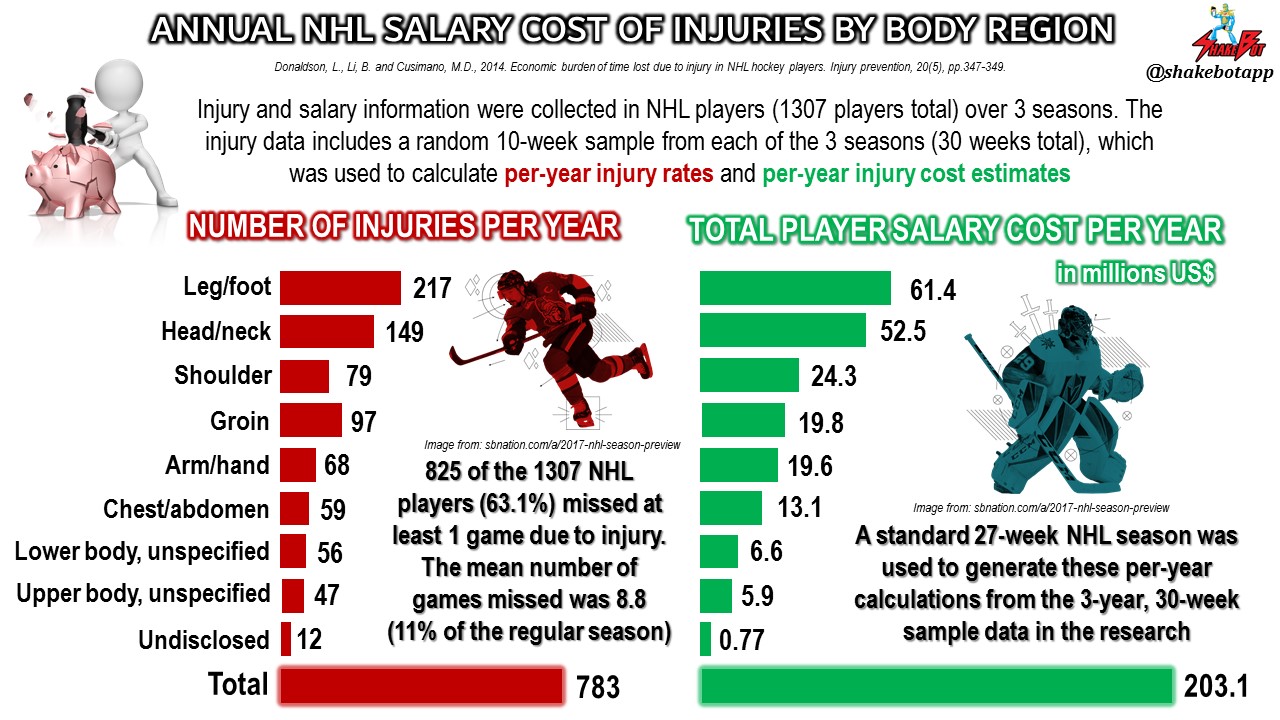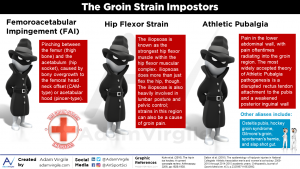Having healthy hips is an integral facet of sustained, high-level ice hockey performance. Due to their heavy use in the sport, they are frequently injured. The financial, performance, and time-loss costs can be extremely burdensome.
In Case You Missed It
In case you missed Parts 1, 2, or 3 of this comprehensive article series, you can view them here, here, and here. I strongly advise taking the time to go through each of these articles, at some point. I intentionally broke up this article series into many parts to make the content of each article more easily digestible.
The Salary Cost of Injury
There was a recent study investigating the financial cost associated with games missed due to injury, in a cohort of all 1307 NHL players playing between 2009-2012 (3 seasons), [1]. Over this time span, the mean salary cost associated with a player missing games because of injury, during a single season, was $260,300 and the total lost salary per player over the 3-year study period was ~$790,000 [1]. The authors, then, used a 30-week sample of injury data over the 3-year span (10 weeks per season). There were 870 total observed injuries during this 30-week span, 108 of which were groin-related (12.4%). The average player salary wasted due to missed games relating to groin injuries during this 30-week sample was $203,900, or $68,000/year. The NHL regular season in 2017-18 lasted 27 weeks. If these numbers are extrapolated to accommodate for the 27-week season, the total salary cost of games missed via groin-related injuries over the 3-year span would be ~$550,500, or $183,600/year, and this data set does not include pre-season or playoffs. Additionally, 30% and 3.2% of the observed injuries were related to the leg/foot and lower body (unspecified), respectively [1]. Some of these injuries could have been hip-related, as well.

Using the recorded 108 groin-related injuries during the 30-week sample over the 3-year timeframe, it could be estimated that 97 groin-related injuries occur each season. This differs dramatically from estimates made by Emery and colleagues in 1999 [2]. Emery and colleagues made a conservative estimate of the impact of groin/abdominal injury on each NHL team being a game loss of 25 player games/year [2]. League-wide (using 31 teams), this would equate to 775 player games/year lost due to groin/abdominal injury. It’s likely that the actual player games lost to groin pain falls somewhere in between these two estimates.
The Other Financial Costs
Salary losses only represent a portion of the financial burden associated with injuries; the true cost of player injuries could be significantly higher. Costs of treatment, personal issues relating to the injury, post-career medical care, loss of fan-generated revenue, as well as the cost of potentially limiting the number of team games played in the postseason, may all have impacts on the total injury costs. Additionally, when an injury is added to a player’s preceding injury history, long-term salary losses may occur, dependent on contract statuses. It should be noted that the injuries used in the analyses by Donaldson et al. (2014) are merely publicly available injuries; team medical records were not examined, which may limit the number of injuries recorded.
The Time and Future Performance Costs
These financial implications are typically seen as short-term burdens, but this is not always the case. As mentioned in Part 3 of this article series, femoroacetabular impingement (FAI) is the most commonly diagnosed cause of hip and groin pain in ice hockey players at all ages and levels of play [3-5]. FAI typically requires surgical intervention, requiring an average of 4 months before return to on-ice drills following surgery, in NHL players [6]. Four months doesn’t seem like long, but reaching pre-injury performance is not guaranteed, which can have drastic future salary and success ramifications. A recent study found that only 74% of athletes diagnosed with FAI return to sport at preinjury level following surgery, on average [7]. Professional athletes are typically able to return to full sports participation at a higher rate, compared with recreational and collegiate athletes, however [8].
There’s another cost to acute injury, regardless of whether the injury occurs in the hip region. Previous injury increases susceptibility to sustaining a similar injury in the future, which could result in subsequent time losses [9]. Even previous injury in the lower body can result in increased injury risk for sustaining another lower body injury, at a different site than the first [10, 11]. The subsequent increased risk for injury in the lower extremities is a well-known consequence of previous injury. While data is limited in ice hockey, specifically, the overall body of research suggests that previous injury is the number one predictor for subsequent injury for the lower extremity, including the hip/groin region specifically, in various cohorts [9, 12-23]. Although the focus is on time losses in this section, it is easy to see how the predisposition to future injury can result in direct salary losses of future contract(s) for the player, and in-season salary losses from a team management perspective. In Part 5 of this article series, I’ll give my thoughts on how to apply an appropriate screen to identify athletes at increased risk for hip injury.
Summary
In the NHL, it’s more likely that a player misses at least one game due to injury than a player completing an entire season injury-free. Just using a small sample of data between 2009-2012, 63.1% of NHL players missed at least one game due to injury, with the average player missing 9 games.
The cost of injury is high; far higher than one might think. First, and probably least important, the player’s salary is being wasted when they are not playing in games; the player is getting paid to not play. The cost of recovery treatment, personal issues relating to the injury, post-career medical care, loss of fan-generated revenue from the games the player missed, as well as the cost of potentially limiting the number of team games played in the postseason, may all have impacts on the total injury-related costs. Additionally, when an injury is added to a player’s preceding injury history, long-term salary losses may occur, dependent on contract statuses.
Perhaps the greatest costs of injury are the increased likelihood for future injury, and compromised long-term health. Once an injury is sustained, a player becomes more susceptible to sustaining a similar injury in the future, which could result in subsequent missed game action, adding to the costs listed above. From the player’s perspective, predisposition to future injury can result in direct salary losses of future contract(s), reduced performance, and internal psychological warfare. From a team management perspective, predisposition for future injury can translate into in-season salary losses, reduced team performance, and financially unfavorable team management decisions (trades, waivers, sending players up/down from minor league, etc.).
For a brief overview of the importance of the hip in ice hockey, go here.
To see how susceptible the hip is to injury and the risk factors for groin strains, go here.
To see the different types of hip/groin injuries that can occur, go here.
To see how to develop a hip screening and monitoring protocol, go here.
To see how to treat different types of hip pain, go here.
To see how early ice hockey specialization (i.e. year-round participation) can negatively impact the hips, go here.
Reference
- Donaldson, L., Li, B. and Cusimano, M.D., 2014. Economic burden of time lost due to injury in NHL hockey players. ?Injury prevention?, ?20?(5), pp.347-349
- Emery, C.A., Meeuwisse, W.H. and Powell, J.W., 1999. Groin and abdominal strain injuries in the National Hockey League. ?Clinical journal of sport medicine: official journal of the Canadian Academy of Sport Medicine?, ?9?(3), pp.151-156.
- Stull, J.D., Philippon, M.J. and LaPrade, R.F., 2011. “At-risk” positioning and hip biomechanics of the Peewee ice hockey sprint start. The American journal of sports medicine, 39(1_suppl), pp.29-35.
- Ayeni, O.R., Kowalczuk, M., Farag, J., Farrokhyar, F., Chu, R., Bedi, A., Willits, K. and Bhandari, M., 2014. Trends in reporting of mechanisms and incidence of hip injuries in males playing minor ice hockey in Canada: a cross-sectional study. Open access journal of sports medicine, 5, p.143.
- Shindle, M.K., Marx, R.G., Kelly, B.T., Bisson, L. and Burke III, C.J., 2010. Hockey injuries: a pediatric sport update. ?Current opinion in pediatrics?, ?22?(1), pp.54-60.
- Philippon, M.J., Weiss, D.R., Kuppersmith, D.A., Briggs, K.K. and Hay, C.J., 2010. Arthroscopic labral repair and treatment of femoroacetabular impingement in professional hockey players. The American journal of sports medicine, 38(1), pp.99-104.
- Reiman, M.P., Peters, S., Sylvain, J., Hagymasi, S., Mather, R.C. and Goode, A.P., 2018. Femoroacetabular impingement surgery allows 74% of athletes to return to the same competitive level of sports participation but their level of performance remains unreported: a systematic review with meta-analysis. Br J Sports Med, pp.bjsports-2017.
- Casartelli, N.C., Leunig, M., Maffiuletti, N.A. and Bizzini, M., 2015. Return to sport after hip surgery for femoroacetabular impingement: a systematic review. ?Br J Sports Med?, pp.bjsports-2014.
- Ryan, J., DeBurca, N. and Mc Creesh, K., 2014. Risk factors for groin/hip injuries in field-based sports: a systematic review. Br J Sports Med, pp.bjsports-2013.
- Toohey, L.A., Drew, M.K., Cook, J.L., Finch, C.F. and Gaida, J.E., 2017. Is subsequent lower limb injury associated with previous injury? A systematic review and meta-analysis. Br J Sports Med, 51(23), pp.1670-1678.
- Malliaropoulos, N., Bikos, G., Meke, M., Vasileios, K., Valle, X., Lohrer, H., Maffulli, N. and Padhiar, N., 2018. Higher frequency of hamstring injuries in elite track and field athletes who had a previous injury to the ankle-a 17 years observational cohort study. Journal of foot and ankle research, 11(1), p.7.
- Murphy, D.F., Connolly, D.A.J. and Beynnon, B.D., 2003. Risk factors for lower extremity injury: a review of the literature. British journal of sports medicine, 37(1), pp.13-29.
- Whittaker, J.L., Small, C., Maffey, L. and Emery, C.A., 2015. Risk factors for groin injury in sport: an updated systematic review. Br J Sports Med, pp.bjsports-2014.
- Krosshaug, T., Steffen, K., Kristianslund, E., Nilstad, A., Mok, K.M., Myklebust, G., Andersen, T.E., Holme, I., Engebretsen, L. and Bahr, R., 2016. The vertical drop jump is a poor screening test for ACL injuries in female elite soccer and handball players: a prospective cohort study of 710 athletes. The American journal of sports medicine, 44(4), pp.874-883.
- Hägglund, M., Waldén, M. and Ekstrand, J., 2006. Previous injury as a risk factor for injury in elite football: a prospective study over two consecutive seasons. British journal of sports medicine, 40(9), pp.767-772.
- Mosler, A.B., Weir, A., Serner, A., Agricola, R., Eirale, C., Farooq, A., Bakken, A., Thorborg, K., Whiteley, R.J., Hölmich, P. and Bahr, R., 2018. Musculoskeletal Screening Tests and Bony Hip Morphology Cannot Identify Male Professional Soccer Players at Risk of Groin Injuries: A 2-Year Prospective Cohort Study. The American journal of sports medicine, 46(6), pp.1294-1305.
- Hägglund, M., Waldén, M. and Ekstrand, J., 2005. Injury incidence and distribution in elite football—a prospective study of the Danish and the Swedish top divisions. Scandinavian journal of medicine & science in sports, 15(1), pp.21-28.
- Arnason, A., Gudmundsson, A., Dahl, H.A. and Johannsson, E., 1996. Soccer injuries in Iceland. Scandinavian journal of medicine & science in sports, 6(1), pp.40-45.
- McKay, G.D., Goldie, P.A., Payne, W.R. and Oakes, B.W., 2001. Ankle injuries in basketball: injury rate and risk factors. British journal of sports medicine, 35(2), pp.103-108.
- Orchard, J., Seward, H., McGivern, J. and Hood, S., 2001. Intrinsic and extrinsic risk factors for anterior cruciate ligament injury in Australian footballers. The American journal of sports medicine, 29(2), pp.196-200.
- Paterno, M.V., Rauh, M.J., Schmitt, L.C., Ford, K.R. and Hewett, T.E., 2014. Incidence of second ACL injuries 2 years after primary ACL reconstruction and return to sport. The American journal of sports medicine, 42(7), pp.1567-1573.
- Freckleton, G., Cook, J. and Pizzari, T., 2013. The predictive validity of a single leg bridge test for hamstring injuries in Australian Rules Football Players. Br J Sports Med, pp.bjsports-2013.
- Maffey, L. and Emery, C., 2007. What are the risk factors for groin strain injury in sport?. Sports Medicine, 37(10), pp.881-894.



